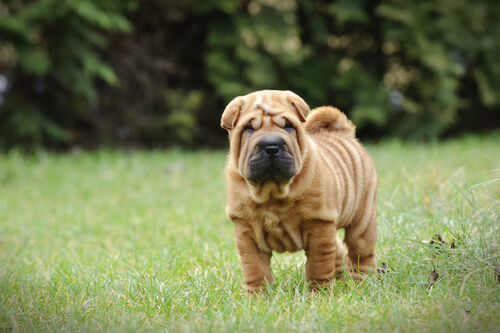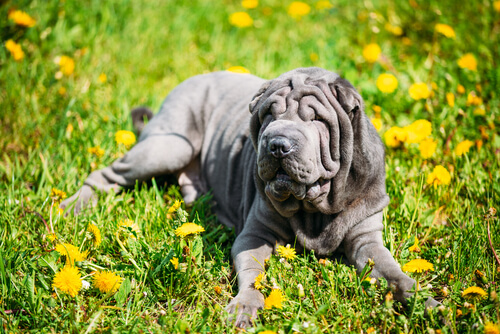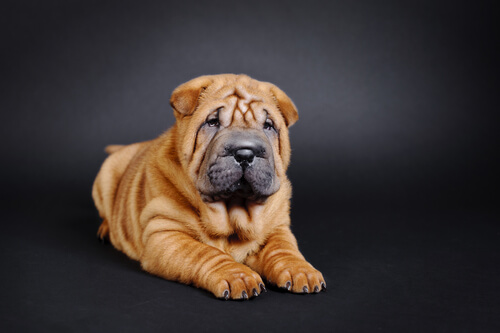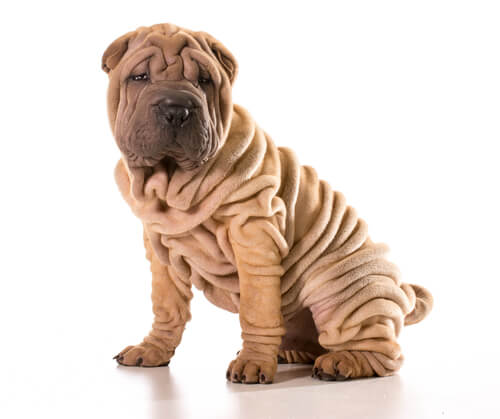
| Kingdom | Animalia |
| Phylum | Chordata |
| Class | Mammalia |
| Order | Carnivora |
| Family | Canidae |
| Genus | Canis |
| Species | C. lupus |
| Species | C. lupus familiaris |
| Niche | Domestic |
| Height | 17-20 inches (44-51 cm) |
| Weight | 35-44 lbs (16-20 kg) |
| Lifespan | 11-12 years |
| Social Structure | Social, domesticated |
| Preferred Habitat | Domestic |
| Average Litter Size | 4-6 puppies |
| Main Food Item | Dog Food |
The Basics
The Chinese Shar Pei is a breed of domestic dogs originating in southern China, where they were bred and kept as guard dogs, hunters, and herders and, eventually for a time, dogfighting. Shar Peis are known for their deep wrinkles and their uniquely colored blue-black tongues. They are a medium-sized breed, typically occurring in tan and blue colorations.

The name “Shar Pei” is likely derived from an English attempt at a Cantonese phrase meaning “sand skin”. This is in reference to the short, rough coat that the Shar Pei is known for. Traditionally, Chinese Shar Pei adults were less wrinkly than many modern-day variants of the breed. As a puppy, however, all individuals are highly wrinkled, but often eventually grow into their skin.
Despite the variant of the breed, the Shar Pei weighs about 35-44 lb (16-20 kg) and stands about 17-20 in (44-51 cm) tall at its withers (shoulders). Their coats are typically tan or a steel-gray variant referred to as ‘blue’. They have small, folded ears and a short, dark muzzle and snout. They also have unique tongues, which are colored a mix of black, blue, or even a purplish color. Their tails are thick and round, curling up over their backs.
As Pets
The Chinese Shar Pei was used in China for centuries as guard dogs, so it is a breed loyal to its owners and families. Historically, they were very versatile, being used for various tasks. They have a moderate energy level and are generally quite calm if not somewhat aloof. Despite not being a small dog, they can often adapt well to apartment life. Like all dogs, exercise is vital, but the Shar Pei does not require a particularly large amount of daily activity.
They are naturally stubborn and require consistently firm training. It is important to begin training and socialization as early as possible. The Shar Pei learns quickly as long as one can overcome its independent streak.

Their short snout and thick skin leave them prone to overheating. It also means that the breed is prone to heavy breathing and snoring. Grooming Chinese Shar Pei is quite easy due to its short and firm coat. They are quite clean, and little bathing or brushing is required. Due to the extreme folds in some individuals, they can be prone to skin conditions. Females typically give birth to litters of about 4-6 puppies.
Fun Facts about Chinese Shar Pei!
Despite their undeniably centuries-long history in China, the Shar Pei was little known in the West until relatively recently. Also, their lineage in China may be so long that it’s hard to tell exactly when the breed began.
A Mysterious Origin
There are no written records indicating when the Shar Pei was originally domesticated. Some historians believe it is an ancient breed, and it undoubtedly got its start in southern China. Some effigies from the Han dynasty, some 1 800 years ago, contain dogs resembling modern-day Shar Pei. These dogs were apparently used as guard dogs, and predate the better-documented emergence of the Chinese Shar Pei and Chow Chow during the 1800s. It was during this century that they were first recognized in The West, where they were known as “Chinese fighting dogs” due to their most frequent use by Chinese nobility at the time. They were finally recognized by the American Kennel Club in 1991, the 134th such breed.

Unfair Stereotypes
The Shar Pei is well-known for two things: its wrinkles and its history as a fighting breed. However, it is little known that there are in fact two variants of the Shar Pei. One is known as the “meat-mouth” Shar Pei and is the classic, very wrinkled version of the breed. However, the “bone-mouth” variant is much less wrinkled and is more reminiscent of the dogs it is believed the Shar Pei is descendant from.
Also, the Shar Pei was used for centuries for other purposes before it was used as a fighting dog by the elite and Chinese nobility. In addition to being guard dogs originally, they were also capable herd dogs as well as hunters. They would hunt animals like boars. Fortunately, following the Chinese Revolution, the practice of fighting Shar Pei began to diminish, due largely to its reputation as a frivolous activity of elitists.
An Undying Breed
Following the Chinese Revolution and the creation of the People’s Republic of China, the Shar Pei became increasingly rare. In fact, by the 1970s, the Shar Pei was one of the rarest dog breeds in the world. It is still not nearly as popular as it used to be, but it did see a resurgence in popularity by the 1980s thanks to breeders in Hong Kong and Taiwan. In fact, one particular Hong Kong man, named Matgo Law of Down-Homes Kennels, may be responsible for the breed’s survival.
Unfortunately, the following resurgence of the breed’s popularity, along with irresponsible breeding practices, led to various health problems being introduced to it. With fewer breeders today, they are able to eliminate such issues from the breed as well as preserve its loving, loyal temperament.
